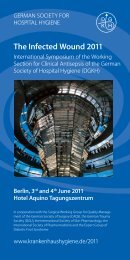Anforderungen an die Hygiene bei der Auf - Deutsche Gesellschaft ...
Anforderungen an die Hygiene bei der Auf - Deutsche Gesellschaft ...
Anforderungen an die Hygiene bei der Auf - Deutsche Gesellschaft ...
Erfolgreiche ePaper selbst erstellen
Machen Sie aus Ihren PDF Publikationen ein blätterbares Flipbook mit unserer einzigartigen Google optimierten e-Paper Software.
3<br />
Empfehlung <strong>der</strong> Kommission für Kr<strong>an</strong>kenhaushygiene und Infektionsprävention <strong>bei</strong>m Robert Koch-Institut (RKI)<br />
Recommendation of the Commission for Hospital <strong>Hygiene</strong> <strong>an</strong>d Infection Prevention at the Robert Koch Institute (RKI)<br />
-- kontaminierte Dosier<strong>an</strong>lage,<br />
• kontaminierte Schlauchsysteme, Behälter o<strong>der</strong> Reinigungs-Desinfektions-Geräte,<br />
• kontaminiertes Leitungswasser o<strong>der</strong> unsteriles Aqua<br />
destillata als Spüllösung,<br />
• Fixierung von org<strong>an</strong>ischem Material und Inkrustrierung<br />
von Mikroorg<strong>an</strong>ismen<br />
Mängel o<strong>der</strong> konstruktive Beson<strong>der</strong>heiten des K<strong>an</strong>alsystems<br />
des Endoskopes<br />
• z. B. englumige, verzweigte o<strong>der</strong> einer Bürstenreinigung<br />
nicht zugängliche K<strong>an</strong>äle (z. B. Spülk<strong>an</strong>al,<br />
Albar<strong>an</strong>k<strong>an</strong>al),<br />
• Bildung eines mikrobiellen Biofilms in den Endoskopk<strong>an</strong>älen,<br />
• Perforation des Instrumentierk<strong>an</strong>als mit Übertritt von<br />
Mikroorg<strong>an</strong>ismen in den Innenhohlraum des Endoskopes<br />
Mängel des endoskopischen Zusatzinstrumentariums<br />
und Optikspülsystems<br />
• nicht korrekt aufbereitetes Zusatzinstrumentarium<br />
(Biopsiez<strong>an</strong>ge, Schlinge etc.),<br />
• kontaminiertes Leitungswasser o<strong>der</strong> unsteriles Aqua<br />
destillata zur Befüllung <strong>der</strong> Optikspülflasche,<br />
• Bildung eines mikrobiellen Biofilms in <strong>der</strong> Flasche<br />
o<strong>der</strong> dem Anschlussschlauch des Optik-Spülsystems<br />
<strong>bei</strong> nicht korrekter <strong>Auf</strong>bereitung<br />
Fehler <strong>bei</strong> <strong>Auf</strong>bewahrung und Tr<strong>an</strong>sport des Endoskopes<br />
• unzureichende Trocknung nach <strong>Auf</strong>bereitung (Vermehrung<br />
von typischen Wasserbakterien wie Pseudomonas<br />
spp., Legionella spp. <strong>bei</strong> Restfeuchtigkeit<br />
in den Endoskopk<strong>an</strong>älen),<br />
• <strong>Auf</strong>bewahrung o<strong>der</strong> Tr<strong>an</strong>sport des Endoskops im<br />
Vers<strong>an</strong>dkoffer,<br />
• nicht rekontaminationsgeschützte Lagerung (z. B.<br />
offen hängend im Untersuchungsraum) o<strong>der</strong> ungeschützter<br />
Tr<strong>an</strong>sport von Endoskopen (z. B. zu externen<br />
Untersuchungen)<br />
Infektionen via Endoskop sind prinzipiell vermeidbar,<br />
daher müssen alle Maßnahmen <strong>der</strong> Infektionsprophylaxe<br />
konsequent umgesetzt werden. Ziel <strong>der</strong> vorliegenden<br />
Empfehlung ist <strong>die</strong> Beschreibung geeigneter und<br />
bewährter Maßnahmen, <strong>die</strong> eine Infektionsübertragung<br />
verhin<strong>der</strong>n. Nach § 4, Abs. 2 <strong>der</strong> Medizinprodukte-<br />
Betreiber-Verordnung (MPBetreibV) sind Reinigung,<br />
Desinfektion und Sterilisation von Medizinprodukten<br />
unter Berücksichtigung <strong>der</strong> Angaben des Herstellers mit<br />
geeigneten vali<strong>die</strong>rten Verfahren durchzuführen. Ferner<br />
ist <strong>die</strong> Nachvollziehbarkeit <strong>der</strong> Abläufe zur Erzielung des<br />
Verfahrenserfolges, nicht zuletzt für behördliche Kontrollen,<br />
zu dokumentieren (Kategorie IV). Hinsichtlich <strong>der</strong><br />
<strong>Auf</strong>bereitung starrer Endoskope und des Zusatzinstrumentariums<br />
wird auch auf <strong>die</strong> gemeinsamen Empfeh-<br />
• contaminated hose systems, receptacles or<br />
washer-disinfectors;<br />
• contaminated tap water or unsterile distilled water<br />
used as a rinsing solution;<br />
• fixation of org<strong>an</strong>ic matter <strong>an</strong>d encrustation of<br />
microorg<strong>an</strong>isms<br />
Deficiencies or construction features of the endoscope‘s<br />
ch<strong>an</strong>nel system<br />
• e.g. narrow-lumen or br<strong>an</strong>ched ch<strong>an</strong>nels or ch<strong>an</strong>nels<br />
which are not accessible for brush cle<strong>an</strong>ing<br />
(e.g. rinsing ch<strong>an</strong>nel or Albarr<strong>an</strong> ch<strong>an</strong>nel);<br />
• formation of microbial biofilm in the endoscope<br />
ch<strong>an</strong>nels;<br />
• perforation of the instrument ch<strong>an</strong>nel with microorg<strong>an</strong>isms<br />
moving into the internal cavity of the endoscope<br />
Deficiencies of endoscopic accessories <strong>an</strong>d the lens<br />
rinsing system<br />
• not correctly reprocessed accessories (biopsy forceps,<br />
snares etc.);<br />
• contaminated tap water or unsterile distilled water<br />
for filling the water bottle,<br />
• formation of microbial biofilm in the bottle or the connecting<br />
hose of the water bottle in case of incorrect<br />
reprocessing<br />
Faults in storing <strong>an</strong>d tr<strong>an</strong>sporting endoscopes<br />
• insufficient drying after reprocessing (propagation of<br />
typical water bacteria, such as Pseudomonas spp.,<br />
Legionella spp. in case of residual moisture in endoscope<br />
ch<strong>an</strong>nels);<br />
• storage or tr<strong>an</strong>sportation of the endoscope in the<br />
dispatch case;<br />
• storage without protection against recontamination<br />
(e.g. endoscopes h<strong>an</strong>ging openly in the examination<br />
room) or unprotected tr<strong>an</strong>sportation of endoscopes<br />
(e.g. to external examinations)<br />
2.<br />
Allgemeine <strong>Anfor<strong>der</strong>ungen</strong> und Ziele<br />
2.<br />
General Requirements <strong>an</strong>d Objectives<br />
2.1<br />
Ziele<br />
2.1<br />
Objectives<br />
Infections through endoscopes c<strong>an</strong>, broadly speaking,<br />
be avoided. This is why all infection prophylaxis measures<br />
must be implemented firmly. The objective of<br />
these recommendations is to describe adequate <strong>an</strong>d<br />
well-tried measures of preventing infection tr<strong>an</strong>smission.<br />
Pursu<strong>an</strong>t to § 4, para. 2 of the Germ<strong>an</strong> Medical<br />
Devices Operator Ordin<strong>an</strong>ce (MPBetreibV), cle<strong>an</strong>ing,<br />
disinfection <strong>an</strong>d sterilisation of medical devices must be<br />
performed using suitable validated methods <strong>an</strong>d bearing<br />
the m<strong>an</strong>ufacturer‘s instructions in mind. Moreover,<br />
traceability of the processes is to be documented for<br />
achieving the method‘s desired result <strong>an</strong>d not least for<br />
official controls (Category IV). Reference is also made<br />
to the common recommendations of the Commission<br />
for Hospital <strong>Hygiene</strong> <strong>an</strong>d Infection Prevention <strong>an</strong>d the<br />
Erstmalig veröffentlicht in Bundesgesundheitsbl Gesundheitsforsch – Gesundheitsschutz | first published in Fe<strong>der</strong>al Health Gazette Health Research – Health Protection<br />
2002 • 45:395–411 © Springer-Verlag 2002



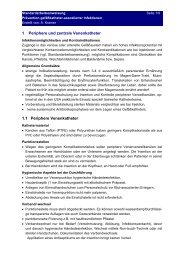
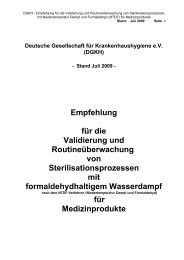


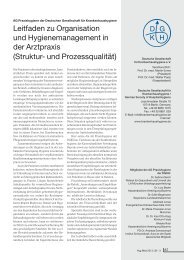

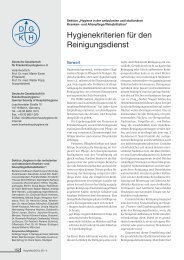


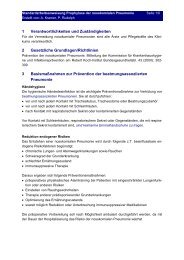


![Hauptprogramm [A4-Quer] - Deutsche Gesellschaft für ...](https://img.yumpu.com/6449478/1/184x260/hauptprogramm-a4-quer-deutsche-gesellschaft-fur-.jpg?quality=85)
